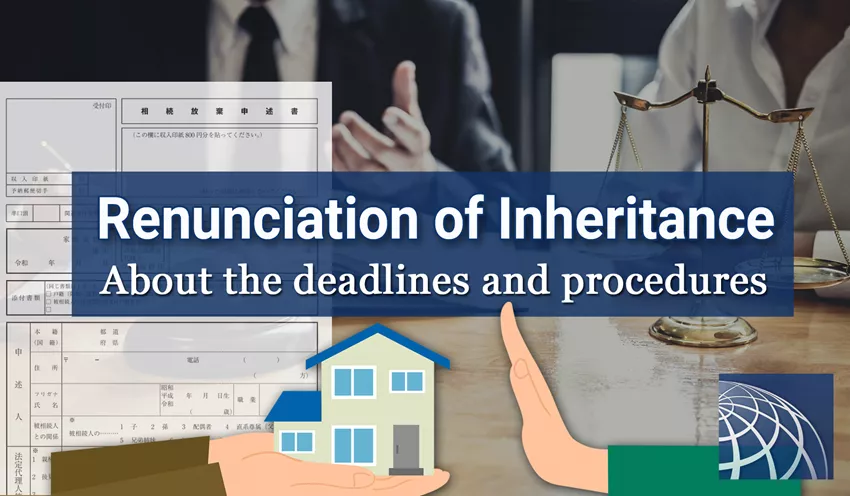What is Renunciation of Inheritance? About the deadlines and procedures

There are 3 types of “inheritance” methods in Japan, which are unconditional acceptance, limited acceptance, and renunciation of inheritance. Here is an explanation about renunciation of inheritance.
Unconditional acceptance: To inherit all the rights and obligations of an ancestor, which means inheritance of all positive assets and negative assets such as debts.
Limited acceptance: To inherit only when there are positive assets after paying off all the negative assets such as debts. It is a good method when you don’t know if the final asset value will be positive or negative after paying off all the negative assets.
Renunciation of inheritance: It is a good method when you don’t want inheritance itself, such as when there are more negative assets than positive assets.
1. What is renunciation of inheritance?
Renunciation of inheritance means that an heir renounces his/her right to inherit any of legacy when the heir does not want to inherit the legacy of the ancestor (a deceased person). Inheritance property includes not only “positive assets such as real estate properties and bank deposits” but also “negative assets such as liabilities”. By renouncing the right to inherit them, you are not an heir from the beginning of any inheritance procedures.
2. Until when should an heir take legal procedure for renunciation?
An heir must report to the local family court that he/she intends to renounce inheritance “within 3 months of the time when he/she has knowledge that there has been a commencement of inheritance for him/her.
*Generally, the time an heir has knowledge that there has been a commencement of inheritance for him/her means the day when the ancestor died, and the 3 months is calculated by a method that does not include the first day when the ancestor died.
Example: When an ancestor died on January 1st, 3 months after calculating from January 2nd which is the following day, and the deadline shall be no later than 12:00p.m. on April 1st (midnight).
3. Where and how does an heir renounce inheritance?
An heir can either go to the family court that has jurisdiction over the address where the ancestor (deceased person) lived just before his/her death to file a statement of renunciation of inheritance or send it to the family court by mail. (Some courts do not accept the application by mail.)
*If you do not know the court having jurisdiction, you can search on the website of the Family Court of Japan.
4. Documents required for the procedure
・A copy of an ancestor’s deleted residence record (or Supplementary family register)
・Statement of Renunciation of Inheritance
https://www.courts.go.jp/vc-files/courts/file2/2019_souzokuhouki_m.pdf
・Copy of a family register of a person who makes the statement (a person who renounces inheritance)
In addition to the above documents, there may be some necessary documents, but the necessary documents vary depending on the relationship between the deceased person and the person who makes the statement.
You can check the details on the court's website and download the petition.
5. Costs required for the procedure
・ Revenue stamp fee JPY800 per person who makes a statement
・ Fee for obtaining a Certificate of Residence and Family Register
・ Postage stamp fee for contact with the court (About the amount of the fee, please consult with the family court to which you make a statement)
6. The flow of procedures after filing a statement
Later, a person who has made a statement will receive an inquiry form (a letter of inquiry regarding the contents of the written statement) from the court, so he/she shall reply to the family court by surface mail. In response to the contents of the written reply, if the family court accepts the statement of renunciation of inheritance, a "Notice of Acceptance of The Statement of Renunciation of Inheritance" will be surface mailed to him/her. (After returning the inquiry form, it is estimated within 1 week to 10 days) the procedures of the renunciation of inheritance are completed with this notice.
*Depending on the content of the inquiry form, the renunciation of inheritance may be rejected.
7. Others
It is possible for an heir to proceed with the renunciation of inheritance by himself/herself, but there are many difficult matters to handle by an individual, such as determining whether or not it is better to renounce inheritance, handling the heirs other than himself/herself, and how to fill in the documents to submit. It may be one solution to ask a lawyer or judicial scrivener for the procedures although it costs some money.
Estimated fees
・ Lawyer fee (acquisition of family register, etc. , preparation of necessary documents, and response to the court):
About JPY 100,000 to JPY 200,000
・ Judicial scrivener fee (only acquisition of family registers, etc. and preparation of necessary documents):
About JPY 30,000 to JPY 50,000

- Rental Apartments & Houses in Tokyo
- Listings of popular and luxurious rental apartments, condominiums, and houses designed with expats in mind.

- Apartments & Houses for Sale in Tokyo
- Listings of apartments, condominiums, and houses available for purchase in Tokyo.





















